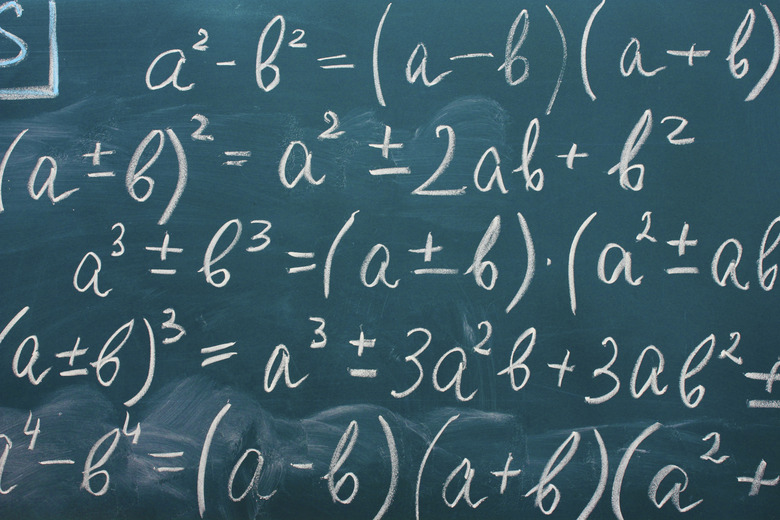What Is Factoring In Math?
If you know the basics of multiplication and division, you already know all the skills you need to factor. A number's factors are simply any numbers that can be multiplied to create that number. You can also factor a number by dividing it repeatedly. While factoring large numbers can feel difficult at first, there are several simple tricks you can learn to quickly find a number's factors.
Factors of a Number
You can find the factors of a number by finding all the terms that multiply together to create that number. For instance, the factors of 14 are 1, 2, 7, and 14, since,
14 = 1 x 14 14 = 2 x 7
To completely factor a number, reduce it to its factors that are prime numbers. These are referred to as the number's "prime factors." For example, 6 and 8 are factors of 48, since,
6 x 8 = 48.
But 6 and 8 are not prime numbers, because they have factors other than 1 and themselves. To completely reduce 48 to its prime factors, you need to factor 6 and 8, too.
2 x 3 = 6 2 x 2 x 2 = 8
So the prime factors of 48 are,
3 x 2 x 2 x 2 x 2 = 48
Factoring Trees
You can use a factoring tree to easily visualize splitting a large number into its prime factors. Place the number you wish to factor at the top of the expression, and divide it in steps by its factors. Each time you divide a number, place the number's two factors below. Continue dividing until all numbers have been reduced to their prime factors. For example, you can factor 156 using a factor tree as follows:
\(156
/\)
2 78 / \ 2 39 / \ 3 13
You can now easily see the prime factors of 156:
2 x 2 x 3 x 13 = 156
You can also divide by composite (or non-prime) factors to create a factor tree. When you divide by a composite factor, you then divide the composite factor into its prime factors. For example, you can factor 192 using either composite or prime factors as follows:
\(192 192
/ \ / \
8 24 2 96
/ \ / \ /\)
4 2 2 12 3 32 / \ / \ / \ 2 2 3 4 2 16 / \ / \ 2 4 2 8 / \ 2 4 / \ 2 2
So the prime factors of 192 are,
2 x 2 x 2 x 2 x 2 x 3 = 192
Factoring With Variables
Variable expressions — yes, the ones with letters in them — also have factors. If a variable is multiplied by a constant (defined number), the variable is one of the expression's factors. For instance,
4y = 2 x 2 x y
You can find factors for expressions that include both variables and constants. For instance, you can factor the expression 6y – 21 by 3, since both 6 and 21 are divisible by three. This leaves you with,
6y – 21 = 3(2y – 7)
Greatest Common Factors
Once you've grasped the basics of factoring, you might be given a problem that asks you to find the greatest common factor of two numbers or expressions. You can find the greatest common factor by creating a list of both numbers' factors. The greatest common factor is simply the largest number that appears on both lists.
For example,
The factors of 48 are 1, 2, 3, 4, 6, 8, 12, 16, 24, and 48 The factors of 56 are 1, 2, 4, 7, 8, 14, 28, and 56
If you compare the two sets of factors, the largest number that's in both sets is 8. So the greatest common factor is 8.
You can also use factor lists to find the greatest common factor of two variable expressions. Let's say you were given the following expressions:
8y 14y^2 – 6y
First, find the all the factors of each expression. Remember that you can include variables in an expression's factors.
The factors of 8y are 1, y, 2, 2y, 4, 4y, 8, and 8y The factors of 14y^2 – 6y are 1, y, 2, 2y, 7y – 3, 7y^2 – 3y, 14y – 6, and 14y^2 – 6y
So the greatest common factor of both expressions is 2y. Note that 2 is not the greatest common factor, since the expressions divided by 2 (4y and 7y^2 – 3y) can both still be divided by y.
Cite This Article
MLA
Zamboni, Jon. "What Is Factoring In Math?" sciencing.com, https://www.sciencing.com/factoring-math-6590887/. 24 April 2017.
APA
Zamboni, Jon. (2017, April 24). What Is Factoring In Math?. sciencing.com. Retrieved from https://www.sciencing.com/factoring-math-6590887/
Chicago
Zamboni, Jon. What Is Factoring In Math? last modified March 24, 2022. https://www.sciencing.com/factoring-math-6590887/
